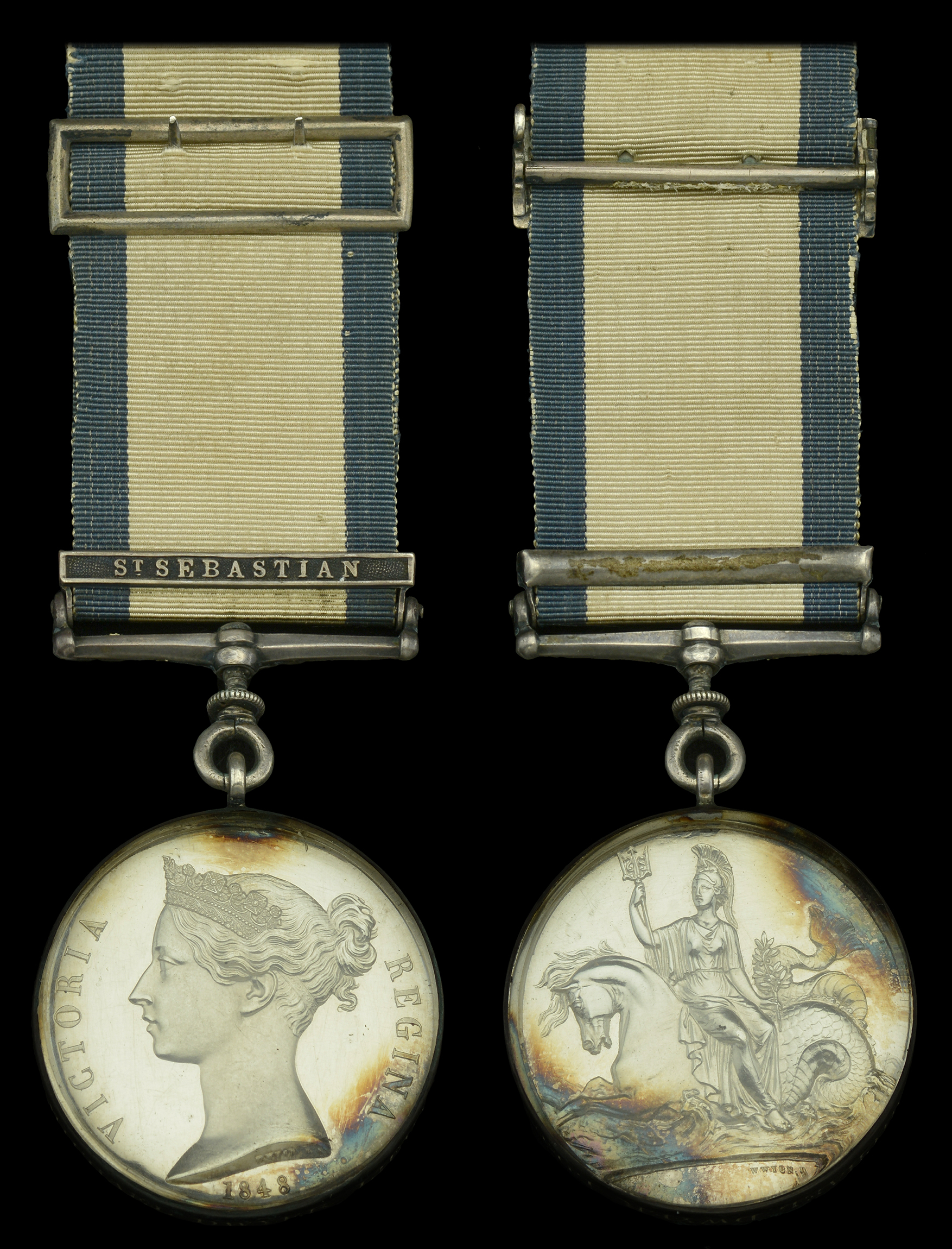The Naval General Service medal awarded to Commander Michael Dwyer, Royal Navy, a Lieutenant in the Révolutionnaire at the siege of St. Sebastian in 1813; a year earlier he had led a party of only seven men landed from H.M.S. Minstrel to successfully storm and spike a battery of 9-pounders garrisoned by 80 Genoese on the coast of Spain, only to be overwhelmed by a detachment of 200 French troops, in the course of which Dwyer was ‘stabbed by a bayonet in seventeen different places of his left arm and side, besides receiving, as in other parts of his body, a desperate gun-shot wound through the right shoulder’ - ‘in admiration of their consummate valour, the prisoners were at once set at liberty by their generous enemy’ Naval General Service 1793-1840, 1 clasp, St. Sebastian (Michael Dwyer, Lieut.) contained in a contemporary Hunt & Roskell glazed silver frame, the edge with engraved naming details, with integral ring and swivel-ring bar suspension and silver ribbon buckle, some tarnishing, otherwise extremely fine £3,000-£4,000 --- Importation Duty This lot is subject to importation duty of 5% on the hammer price unless exported outside the UK --- --- The practise of ‘glazing’ medals in this fashion was an option taken up by some officers at the time of the issue of the Naval, Military and Indian service medals. It was a service known to have been offered and carried out by Hunt & Roskell who were contracted to assemble these medals and clasps. In all known examples where it has been possible to inspect the actual planchet, invariably due to broken lunettes, the naming details have been correctly impressed by the Royal Mint. The published Naval General Service Medal rolls confirm Michael Dwyer as a Lieutenant aboard the Revolutionnaire for the operations off St. Sebastian in September 1813. Michael Dwyer entered the Navy on 17 November 1804, as Able Seaman on board the Galgo sloop, Captain Michael Dodd. From July 1805, until the year 1812, he successively served, as Midshipman and Master’s Mate, in the Unité 36, Captain Charles Ogle, Queen 98, Captain Francis Pender, Zealous 74, Captains John Giffard and William Pierrepont, Bulwark 74, Captain Hon. Charles Elphinstone Fleeming, Téméraire 98, bearing the flag of Rear-Admiral Francis Pickmore, Unité again, Captain Edwin Henry Chamberlayne, and Weasel and Minstrel sloops, both commanded by Captain John Strutt Peyton. During that period, among other services, Mr. Dwyer was actively employed in the blockade of Carthagena and of Toulon, and at the siege of Cadiz; and, when in the Unité, he took part, on 1 May 1811, in a very gallant action of an hour and a half in Sagone Bay, where that frigate, in company with the Pomone 38, and Scout 18, effectually destroyed the two armed store-ships Giraffe and Nourrice, each mounting from 20 to 30 guns, and protected by a 5-gun battery, a martello tower, and a body of about 200 regular troops. On 4 July in the same year he further contributed, in the Unité’s boats, under Lieutenant Joseph William Crabb, to the capture, beneath a shower of grape from a battery at Port Hercule, on the Roman coast, of the armed and vigorously defended brig St. François de Paule; and, in the course of the same day, he assisted Captain A. W. J. Clifford, of the Cephalus, in very spiritedly cutting out three merchant-vessels from between Civita Vecchia and the mouth of the Tiber. On 12 August 1812 – (he had been unknowingly promoted to the rank of Lieutenant by commission dated 21 of the previous March) – we find Mr. Dwyer landing from the Minstrel (as a preliminary step to the capture of three privateers, two of which had been hauled on shore in the port of Biendom, near Alicant), and, at the head of a party of only seven men, successfully storming, in face of a desperate resistance, a battery of 6 9-pounders, garrisoned by eighty Genoese, the crews of the two vessels alluded to. Before, however, Mr. Dwyer and his little band of heroes, after spiking the guns of the battery, could regain their boat, they were surrounded by a detachment of 200 French troops, and were ultimately overwhelmed; but not until, of the British handful, one man had been killed, the six others desperately wounded, and their gallant leader stabbed by a bayonet in seventeen different places of his left arm and side, besides receiving, as in other parts of his body, a desperate gun-shot wound through the right shoulder, which has ever since deprived him of the use of that arm. We may add that, in admiration of their consummate valour, the prisoners were at once set at liberty by their generous enemy; and that Mr. Dwyer, who, as a matter of course, afterwards obtained a pension for his wounds of 91l. 5s., was also presented with an elegant sword by the Patriotic Society. Being next appointed, 16 July, 1813, to the Révolutionnaire 38, Captain John Charles Woolcombe, he occasionally served in the trenches at the ensuing siege of St. Sebastian, and materially hastened the fall of that important place by commanding the division of boats which stormed and captured the island of Santa Clara. He afterwards made a voyage to China, and when at the Cape of Good Hope, in July, 1816, was the chief instrument, by his energy and activity, of saving the Révolutionnaire and her consort the Zebra from destruction, both those vessels having been stranded, during a tremendous hurricane, in Simon’s Bay. Quitting the Révolutionnaire in December 1816, Lieutenant Dwyer subsequently commanded the Bittern tender, of 10 guns, on the Plymouth station, from 12 November 1824, until 7 January 1826; and, on 9 March, 1842, he was appointed to the Fearless surveying-steamer, Captain Frederick Bullock. Being in command of that vessel on the occasion of the Queen’s visit to Scotland, he was at length, on Her Majesty’s return, promoted to the rank of Commander, 21 September 1842.





